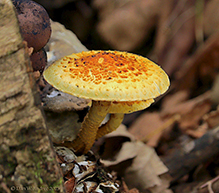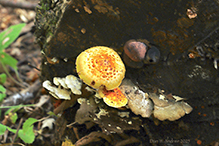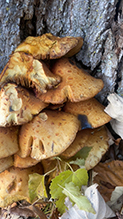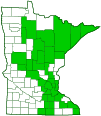Golden Pholiota
(Pholiota aurivella group)
Conservation • Description • Habitat • Ecology • Distribution • Taxonomy
Conservation Status |
|||
| IUCN Red List | not listed |
||
| NatureServe | NNR - Unranked |
||
| Minnesota | not listed |
||
Description |
Golden Pholiota is a common, medium-sized, gilled mushroom. It is often treated as a species complex or group of several similar mushrooms, including Pholiota aurivella, Pholiota limonella, Pholiota abietis, Pholiota connata, Pholiota squarroso-adiposa, Pholiota subvelutipes, and sometimes Pholiota adiposa. Some of these species grow only on conifers, one grows only on hardwoods, and one occurs only in Europe. In field guides and online sources, they are usually all treated as a single species, growing on both conifers and hardwoods, occurring worldwide, and going under the name Pholiota aurivella, Pholiota limonella, or Pholiota glutinosa. The description that follows is of the group. Golden Pholiota occurs in Europe, Asia, eastern Australia, New Zealand, and North America. In the United States it occurs in the east from Maine to northern Georgia, west to Minnesota and Missouri, in the west from western Washington to central California, and in the mountains of Colorado and New Mexico. Outside of these areas it is mostly absent. It is found from mid-summer to late fall usually in clusters. occasionally alone. It grows on living and dead wood of both hardwoods and conifers. It obtains its nutrients from dead wood (saprobic) and probably also from living wood (parasitic). When it first appears, the cap is broadly bell-shaped or convex, yellow, yellowish-brown, or orangish-yellow. The upper surface is covered with large, brownish to reddish-brown scales. The scales are flat but often curl up at the edges. The surface below the scales is slimy when wet, sticky when moist, and smooth when dry. There are often shreds of tissue, remnants of the partial veil, hanging from the margins. As it ages the cap spreads out and the scales wash away or gelatinize and become indistinct. The mature cap is 1½″ to 6″ (4 to 15 cm) in diameter, is broadly convex or flat, and has a raised bump in the middle (umbonate). The gills are closely spaced and are broadly attached to the stalk or notched at the point of attachment. They are whitish to yellow at first, becoming brown to rusty brown or brownish-orange as the spores mature. The stalk is 1½″ to 6″ (4 to 15 cm) long, ⅛″ to 1″ (4 to 25 mm) thick, dry, and whitish, yellowish, or colored like the cap. There is a ring of tissue near the top, remnants of the partial veil. Above the ring it is smooth, below the ring it is sparsely to densely covered with scales. The flesh is yellowish or whitish. Some field guides say that it is edible, but one or more of the species in this group have caused gastric upset in many people. The spore print is brown. |
Similar Species |
Habitat and Hosts |
Living and dead hardwoods and conifers |
Ecology |
Season |
Summer and fall |
Distribution |
||
|
Sources Biodiversity occurrence data published by: Minnesota Biodiversity Atlas (accessed through the Minnesota Biodiversity Atlas Portal, bellatlas.umn.edu, 9/17/2025). |
|
| 9/18/2025 | ||
Occurrence |
||
Common |
||
Taxonomy |
|
Kingdom |
Fungi (Fungi) |
Subkingdom |
Dikarya |
Phylum |
Basidiomycota (club fungi) |
Subphylum |
Agaricomycotina (jelly fungi, yeasts, and mushrooms) |
Class |
Agaricomycetes (mushrooms, bracket fungi, puffballs, and allies) |
Subclass |
Agaricomycetidae |
Order |
|
Suborder |
Agaricineae |
Family |
Strophariaceae |
Genus |
Pholiota (scalycaps) |
Subgenus |
Pholiota |
Section |
Adiposae |
Subordinate Taxa |
|
|
|
Synonyms |
|
Agaricus aurivellus Agaricus aurivellus ssp. aurivellus Agaricus aurivellus var. filamentosus Agaricus ceriferus Agaricus filamentosus Agaricus squarrosus ssp. aurivellus Agaricus squarrosus var. aurivellus Dryophila aurivella Dryophila aurivella var. cerifera Hypodendrum aurivellum Lepiota squarrosa ssp. aurivella Lepiota squarrosa var. aurivella Pholiota aurivella ssp. cerifera Pholiota aurivella var. abietis-nordmanniana Pholiota aurivella var. squarrosipes Pholiota cerifera Pholiota cerifera var. squarrosipes Pholiota lilacifolia Pholiota serifera |
|
Common Names |
|
Golden Pholiota Goldskin Scalecap |
|
Glossary
Partial veil
A protective covering over the gills or pores of a developing mushroom. At maturity it disappears, collapses into a ring around the stalk, or wears away into a cobwebby covering and ring zone.
Saprobic
A term often used for saprotrophic fungi. Referring to fungi that obtain their nutrients from decayed organic matter.
Umbonate
On mushrooms, having a distinct, raised, knob-like projection in the center of the cap.
Visitor Photos
Share your photo of this fungus.
This button not working for you?
Simply email us at info@MinnesotaSeasons.com.
Attach one or more photos and, if you like, a caption.
Bobbi Johnson |
 |
Dan W. Andree |
||
Golden Pholiota... |
||
 |
 |
|
 |
||
Jim Gicking |
 |
base of a sweet gum tree. |
Greg Watson |
 |
MinnesotaSeasons.com Photos
|

Slideshows

Visitor Videos
Share your video of this fungus.
This button not working for you?
Simply email us at info@MinnesotaSeasons.com.
Attach a video, a YouTube link, or a cloud storage link.
Other Videos
Golden Pholiota, 'pholiota aurivella' poisonous non edible mushroom
Freely Farm Exploits
The Inedible Mushroom: Golden Pholiota (Pholiota aurivella) Not Honey Mushroom
The Liu View

Visitor Sightings
Report a sighting of this fungus.
This button not working for you?
Simply email us at info@MinnesotaSeasons.com.
Be sure to include a location.
MinnesotaSeasons.com Sightings |
|





